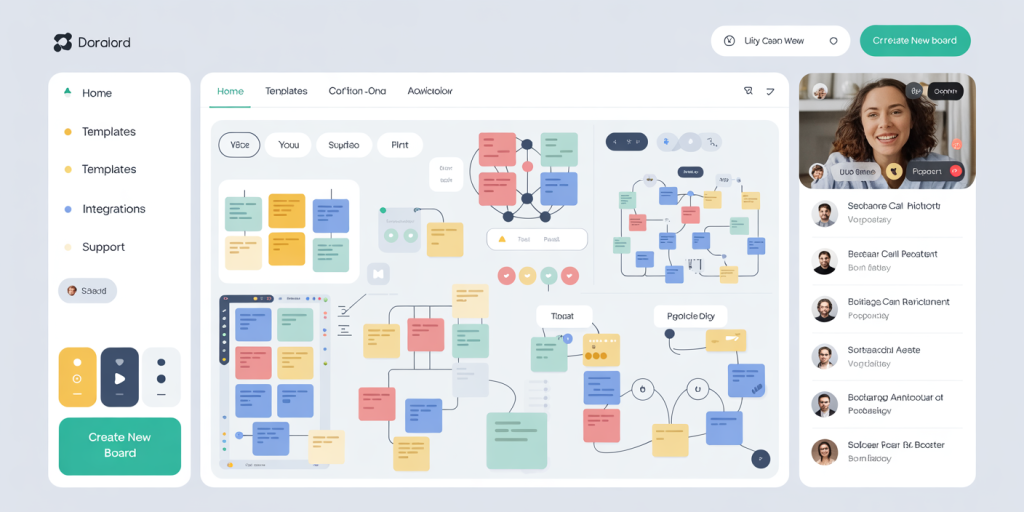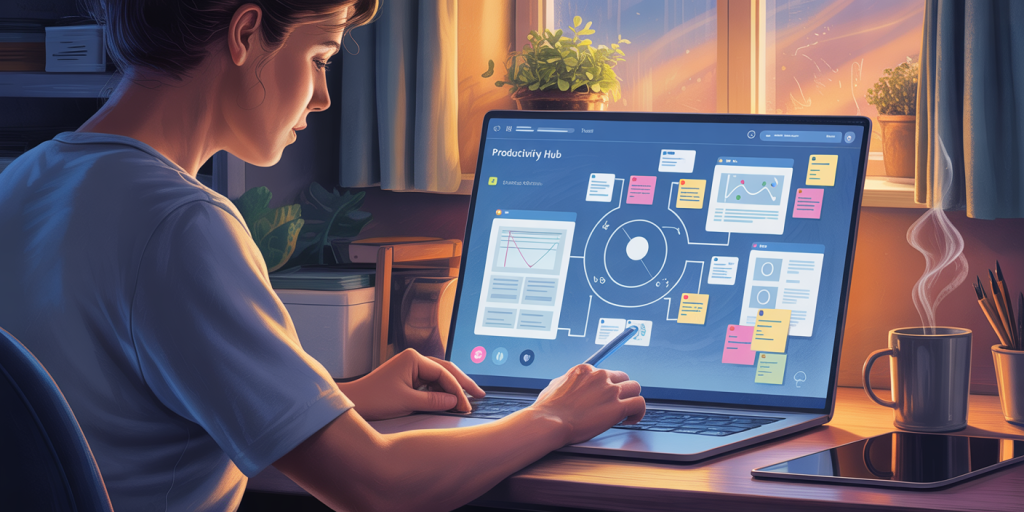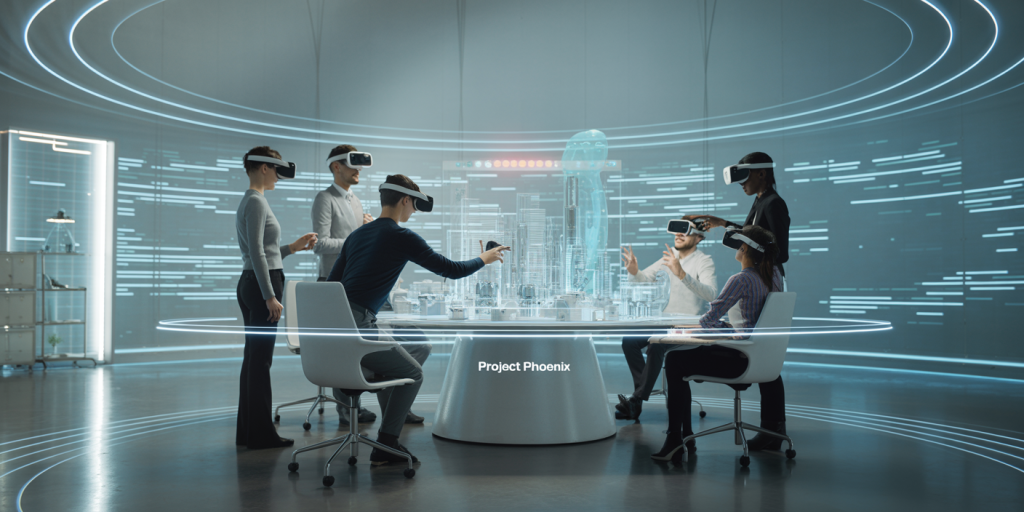Online Whiteboards for Brainstorming Alone or with a Team
In today’s digitally connected era, the need for effective brainstorming tools has never been greater. With the surge in remote work and virtual collaboration, online whiteboards have emerged as an essential resource for individuals and teams aiming to capture ideas quickly, organize thoughts clearly, and foster creativity seamlessly. These platforms recreate the canvas experience, empowering users to visualize concepts, collaborate in real-time, and manage projects more effectively regardless of their physical location.

A dynamic digital online whiteboard interface displaying real-time multi-user brainstorming with sticky notes, mind maps, flowcharts, and chat/video collaboration features, symbolizing seamless team creativity and virtual interaction.
Online whiteboards not only democratize brainstorming by making it accessible at any time, but they also enhance productivity by integrating with other digital ecosystems. From solo ideation to complex team collaborations, these tools support diverse workflows, enabling businesses, educators, designers, and innovators to transform their creative process. According to a report by Grand View Research, the global visual collaboration software market is expected to reach $2.02 billion by 2027, reflecting a compound annual growth rate (CAGR) of 13.8% from 2020 to 2027. This soaring demand underscores the growing reliance on innovative platforms that promote dynamic brainstorming.
The Anatomy of Online Whiteboards: Features and Functionalities
Online whiteboards blend core aspects of traditional brainstorming with advanced digital functionalities. At their core, these tools are digital canvases that allow users to draw, write, insert images, add sticky notes, and map ideas using mind maps or flowcharts. Key features often include multi-user access, version control, drag-and-drop interfaces, and integration with other productivity tools like Slack, Google Drive, and Microsoft Teams.
Anúncios
One of the most acclaimed functionalities is real-time collaboration. Platforms like Miro and MURAL facilitate synchronous brainstorming, allowing multiple participants to contribute simultaneously, see updates in real-time, and communicate through embedded chat or video. This synchronous interaction mimics in-person engagement, which is critical for ideation sessions where instant feedback and rapid iteration drive creativity.
Another vital functionality is the ability to work offline and sync changes once online. This feature is especially useful for individual users who brainstorm alone and may want to jot down ideas when disconnected from the internet. Some tools also offer AI-powered suggestions, auto-alignment of objects, and pre-built templates tailored for specific use cases like SWOT analysis, Design Thinking, or product roadmaps.
As a practical example, a marketing team at a multinational corporation used MURAL in a virtual global campaign brainstorming. The team parceled the whiteboard into sections representing different marketing channels, with each member contributing insights and tagging content experts for validation. The structured yet flexible workspace helped reduce overlapping tasks by 35%, and the final campaign plan was executed 2 weeks ahead of schedule.
Anúncios
| Feature | Miro | MURAL | Jamboard | Microsoft Whiteboard |
|---|---|---|---|---|
| Real-time Collaboration | Yes | Yes | Yes | Yes |
| Offline Mode | Yes | Limited | Yes | Yes |
| Pre-built Templates | Extensive | Extensive | Basic | Moderate |
| AI-powered Suggestions | Yes | No | No | No |
| Third-party Integrations | High | High | Moderate | High |
| Price Range | Freemium to Paid | Freemium to Paid | Free | Free with O365 |
Solo Brainstorming: Enhancing Individual Creativity and Productivity
Online whiteboards are not only for teams; individual professionals can leverage these tools to boost creativity and organize their thoughts systematically. Unlike traditional paper or offline apps, digital whiteboards give solo users the freedom to experiment with complex ideas without wasting physical resources.

A solo professional using an intuitive online whiteboard on a laptop, visually mapping ideas with diagrams, attaching documents, and organizing thoughts creatively in a quiet home office setting to enhance individual productivity.
One significant advantage for solo brainstorming is the capacity to visualize diverse thinking patterns, such as mind mapping, flowcharting, or strategic frameworks, in a single canvas. For example, a product manager working remotely can outline a feature development plan, drag related documents into the board, and map dependencies without switching between multiple apps. This consolidation reduces cognitive load and helps in maintaining focus.
Moreover, the ability to save, revisit, and refine ideas plays a pivotal role in the ideation process. The non-linear format of whiteboards allows users to develop ideas iteratively, adding, removing, or reorganizing elements based on newly found insights or feedback gathered asynchronously later.
Consider the case of freelance writer Amy, who uses Microsoft Whiteboard for structuring her articles. She sketches her outlines, attaches research notes, and visually segments article parts. This method cut down her draft development time by 25%, as she could quickly spot gaps and redundancies using the visual maps.
Statistics from a study conducted by the University of Pennsylvania highlight that visual thinking tools like online whiteboards can improve individual idea generation by up to 30% compared to traditional note-taking, primarily by making abstract ideas tangible and easier to manipulate. Consequently, solo brainstorming becomes more dynamic and productive.
Team Collaboration: Bridging Geographical and Functional Gaps
The rise of remote teams and distributed workforces has amplified the importance of online whiteboards as collaborative spaces. These digital environments offer a versatile platform where team members can brainstorm simultaneously, share feedback openly, and co-create solutions efficiently.
An essential benefit is inclusivity. Online whiteboards ensure that voices from all team members, regardless of hierarchy or location, can be expressed equally. This balanced participation addresses a common pitfall in physical meeting rooms where dominant personalities tend to overshadow quieter colleagues, potentially stifling creativity.
Example: Salesforce employed Miro to conduct remote brainstorming sessions involving cross-departmental teams spread across different continents. By structuring boards into thematic zones, the company could collect input aligned with strategic company goals. Employees reported a 40% increase in perceived collaboration quality, and leadership attributed a 15% reduction in time-to-market for new features to the streamlined brainstorm-to-execution workflow enabled by the tool.
Another critical aspect is integration with project management systems. Many online whiteboards link seamlessly to platforms like Jira or Asana, enabling teams to transition from ideation to task assignment without losing contextual information. This integration fosters agility and accountability within teams.
| Aspect | Physical Whiteboards | Online Whiteboards |
|---|---|---|
| Accessibility | Location-bound | Anywhere with Internet Access |
| Real-time Multi-user Editing | Limited to in-person | Unlimited simultaneous users |
| Space for Ideas | Limited by board size | Virtually unlimited workspace |
| Integration with Tools | Manual | Automated via APIs |
| Idea Preservation | Temporary | Persistent and version-controlled |
| Inclusivity | Low (hierarchical) | High (equal access to contribute) |
The table above contrasts traditional whiteboards with online alternatives, highlighting the transformative potential of digital solutions in team brainstorming.
Industry Applications: Practical Success Stories
Online whiteboards have transcended industry boundaries, finding applications in education, healthcare, corporate strategy, and creative industries. The versatility of these tools manifests in various practical cases where brainstorming requirements differ significantly.
In education, instructors utilize online whiteboards to facilitate interactive lessons and collaborative student projects remotely. For instance, a university professor at Stanford employed Jamboard to conduct interactive problem-solving workshops in engineering courses during the pandemic. Students could annotate diagrams in real-time, submit ideas, and receive live feedback, enhancing engagement by 50% compared to traditional lecturing methods.
Within healthcare, multidisciplinary teams use online whiteboards to map patient treatment plans collaboratively. A hospital in Toronto adopted Miro to coordinate care between doctors, nurses, and social workers for complex cases. This approach resulted in 20% faster consensus on treatment strategies and improved communication transparency.
Creative agencies rely heavily on platforms like MURAL and Miro for developing storyboards, mood boards, and marketing strategies. The iterative nature of whiteboards suits the fluidity and ambiguity often found in creative work, enabling rapid prototyping and client reviews. For example, an advertising firm reduced its concept approval cycles by 30% after adopting an online board for client collaboration.
Furthermore, tech startups use online whiteboards for agile sprint planning, retrospectives, and product design. Spotify credits their cross-functional teams’ success partly to adopting visual collaboration tools that enable efficient story mapping and backlog grooming despite distributed teams.
Collectively, these cases underscore how online whiteboards serve as catalysts across diverse sectors by enhancing communication, creativity, and project execution.
Choosing the Right Online Whiteboard for Your Needs
Selecting an appropriate online whiteboard depends heavily on several factors, including user preferences, team size, collaboration style, budget, and specific feature requirements. Making an informed choice ensures optimal adoption and maximizes the ROI of the tool.
For individuals or small teams, platforms with intuitive interfaces and essential features may suffice. Google Jamboard, integrated with Google Workspace, offers a free solution ideal for quick brainstorming and sharing within the Google ecosystem. However, the feature set is relatively basic compared to specialized tools.
Conversely, larger enterprises with complex workflows might prioritize platforms like Miro or MURAL, which support extensive integrations, advanced security, and comprehensive template libraries. Pricing also varies significantly, with freemium models offering basic unlimited boards but charging for advanced capabilities such as analytics, user management, or AI-powered features.
The table below summarizes key considerations when choosing an online whiteboard:
| Criteria | What to Evaluate | Example Preferences |
|---|---|---|
| Collaboration Needs | Number of users, synchronous/asynchronous | Miro for large teams, Jamboard for small |
| Feature Complexity | Templates, AI features, media support | MURAL for advanced templates |
| Integration with Tools | Compatibility with existing workflows | Microsoft Whiteboard for O365 users |
| Budget | Cost per user, value proposition | Jamboard for free, Miro paid plans |
| Security & Compliance | Data encryption, compliance certifications | MURAL for HIPAA compliance |
Conducting trial runs with multiple tools also provides hands-on insights. Teams at Adobe reported better engagement after switching from an underutilized basic whiteboard to Miro, resulting in a 60% increase in collaborative sessions per month.
Future Perspectives: Evolving Trends in Online Brainstorming Platforms
Looking forward, the trajectory of online whiteboards points towards more immersive, intelligent, and integrated experiences. Artificial Intelligence (AI) is expected to play an increasing role in augmenting brainstorming by suggesting ideas, automating organization, and analyzing patterns in collaboration.
Emerging technologies such as augmented reality (AR) and virtual reality (VR) may redefine how users interact with digital whiteboards, turning brainstorming sessions into immersive environments where participants manipulate 3D models and visualizations. Companies like Spatial and Meta are already experimenting with virtual collaboration spaces that merge whiteboard functionalities with spatial computing.

A futuristic workspace showcasing augmented reality (AR) and virtual reality (VR) integration with 3D models and immersive digital whiteboard collaboration among remote team members wearing VR headsets, representing the future of brainstorming technology.
Additionally, the integration of voice recognition and natural language processing will enable hands-free ideation and the automatic transcription of conversations into structured boards. Enhanced analytics will provide teams with insights into collaboration efficiency, individual contributions, and ideation trends, empowering data-driven creativity.
The shift towards hybrid work models will also push online whiteboards to optimize for asynchronous contribution, offering features like detailed version histories, comment threading, and smart reminders. These improvements ensure continuity in brainstorming regardless of differing schedules and time zones.
Finally, user experience will benefit from continued advancements in mobile and tablet apps, allowing brainstorming to happen spontaneously on-the-go without sacrificing functionality or usability.
As organizations modernize their innovation processes, online whiteboards will increasingly serve as the nexus for creative collaboration—blending technology and human insight to unlock higher levels of productivity and ingenuity.
By embracing online whiteboards, individuals and teams can leverage powerful digital tools to brainstorm more creatively, collaborate more effectively, and realize ideas faster than ever before. The versatility and adaptability of these platforms make them indispensable for the future of work and innovation.
